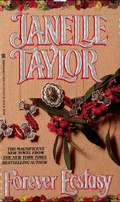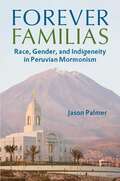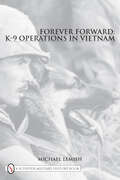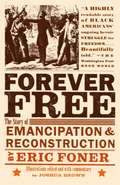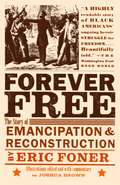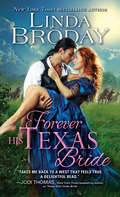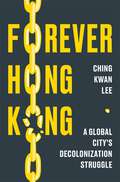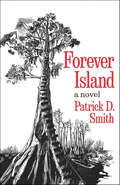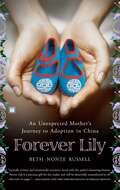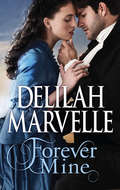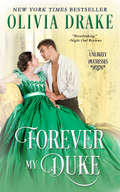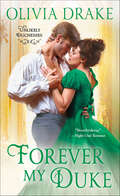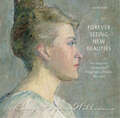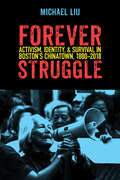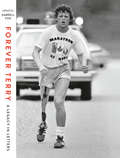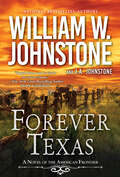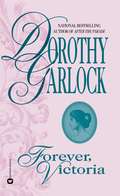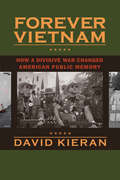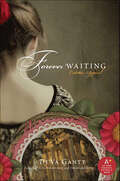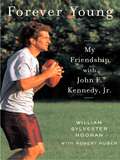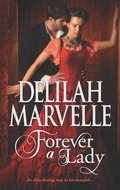- Table View
- List View
Forever Ecstasy (Gray Eagle Series #8)
by Janelle TaylorSAVAGE ECSTATSY. . .WHISPERED KISSES. . .FOLLOW THE WINDThese are just a few of the books that have made Janelle Taylor such a beloved and bestselling author of historical romance. And her sweeping tales of Gray Eagle's love for the beautiful Alisha, and the passion-filled adventures of their descendants are among her most unforgettable novels. Now, at last, the legend continues. . .Forever EcstasyMorning Star knew it was her duty as an Oglala princess to join with a warrior of her tribe. After all, she was the granddaughter of the revered Gray Eagle, and her father was the great Chief Sun Cloud. But the moment she gazed into the sky-blue eyes if Joseph Lawrence, she realized he was fated to be in her life-circle. For he was the man of legend, the white man who would lead her tribe to peace. He was also the lover who would stir her soul with forbidden desires. Together they would know a great destiny. . .and an everlasting love!
Forever Familias: Race, Gender, and Indigeneity in Peruvian Mormonism
by Jason PalmerPeruvian members of the Church of Jesus Christ of Latter-day Saints face the dilemma of embracing their faith while finding space to nourish their Peruvianness. Jason Palmer draws on eight years of fieldwork to provide an on-the-ground look at the relationship between Peruvian Saints and the racial and gender complexities of the contemporary Church. Peruvian Saints discovered that the foundational ideas of kinship and religion ceased being distinct categories in their faith. At the same time, they came to see that LDS rituals and reenactments placed coloniality in opposition to the Peruvians’ indigenous roots and family against the more expansive Peruvian idea of familia. In part one, Palmer explores how Peruvian Saints resolved the first clash by creating the idea of a new pioneer indigeneity that rejected victimhood in favor of subtle engagements with power. Part two illuminates the work performed by Peruvian Saints as they stretched the Anglo Church’s model of the nuclear family to encompass familia.
Forever Forward: K-9 Operations in Vietnam
by Michael Lemish“Forever Forward” is the first in-depth account of K-9 Operations during the Vietnam War, and provides a behind the scenes look at how Allied forces employed dog teams in a variety of roles, the evolution of the United States military working dog program, and the aftermath of Vietnam. The 4,000 dogs that served with our men in Vietnam in every service branch are America’s unsung heroes. American dog teams averted over 10,000 casualties and worked as scouts, sentries, trackers, mine, and tunnel detectors. They were so effective the Viet Cong even placed a bounty on them. Heroes yes, but our own government left most of them behind to an unknown fate.
Forever Free: The Story of Emancipation and Reconstruction
by Eric FonerThis book seeks to bring the fruits of recent scholarship on Reconstruction to a broad popular audience and in doing so, reinforce the point that knowledge of that turbulent era is indispensable to thinking about American society today. The six visual essays that appear in this book chart the ways American visual culture embraced, ignored, and distorted issues of race and equality from the 1840s to the 1920s
Forever Free: The Story of Emancipation and Reconstruction
by Eric FonerFrom one of our most distinguished historians, a new examination of the vitally important years of Emancipation and Reconstruction during and immediately following the Civil War-a necessary reconsideration that emphasizes the era's political and cultural meaning for today's America. In Forever Free, Eric Foner overturns numerous assumptions growing out of the traditional understanding of the period, which is based almost exclusively on white sources and shaped by (often unconscious) racism. He presents the period as a time of determination, especially on the part of recently emancipated black Americans, to put into effect the principles of equal rights and citizenship for all.Drawing on a wide range of long-neglected documents, he places a new emphasis on the centrality of the black experience to an understanding of the era. We see African Americans as active agents in overthrowing slavery, in helping win the Civil War, and-even more actively-in shaping Reconstruction and creating a legacy long obscured and misunderstood. Foner makes clear how, by war's end, freed slaves in the South built on networks of church and family in order to exercise their right of suffrage as well as gain access to education, land, and employment.He shows us that the birth of the Ku Klux Klan and renewed acts of racial violence were retaliation for the progress made by blacks soon after the war. He refutes lingering misconceptions about Reconstruction, including the attribution of its ills to corrupt African American politicians and "carpetbaggers," and connects it to the movements for civil rights and racial justice.Joshua Brown's illustrated commentary on the era's graphic art and photographs complements the narrative. He offers a unique portrait of how Americans envisioned their world and time.Forever Free is an essential contribution to our understanding of the events that fundamentally reshaped American life after the Civil War-a persuasive reading of history that transforms our sense of the era from a time of failure and despair to a threshold of hope and achievement.
Forever His Texas Bride
by Linda Broday"Linda Broday's books always take me back to a west that feels true. Her love stories run deep with emotion. A delightful read." -Jodi Thomas, New York Times bestselling author of Promise Me Texas on Texas Mail Order Bride"There's this thing between us that refuses to die. I'd like nothing better than to be able to..." His words faded. He'd give anything to change people's views about his race...to be able to make her his wife. But the world wasn't that simple. Not for people like them.All his life, Brett Liberty has straddled two worlds: white and Iroquois. The only place he's truly at peace is with his wild mustangs. But after he's arrested for the color of his skin, he discovers Rayna Harper in the cell next to him. Rough and tumble Rayna has known little kindness, but Brett sees the depth of her heart hidden beneath layers of hurt and fear, and he refuses to leave without her.Fierce and loyal, kind and strong, Rayna is everything Brett has ever wanted. But the world doesn't look kindly on a love like theirs, and he would rather let her go than bring her pain. Yet when the demons of his past threaten her future, Brett realizes he will do anything to keep Rayna safe...and make her his.Bachelors of Battle Creek:Texas Mail Order BrideTwice a Texas BrideForever His Texas Bride
Forever Hong Kong: A Global City's Decolonization Struggle
by Ching Kwan LeeAn on-the-ground account of the dramatic 2019 Hong Kong protests, showing how they represent the latest stage of a decades-old decolonization struggle.Long known for its glamour and affluence, Hong Kong shocked the world in 2019 when millions of its citizens took to the streets in protest. For more than six months, Hong Kongers braved the police’s often violent suppression. At the forefront were young adults fighting not just for universal suffrage but for their vision of a good society, a just economy, rule of law, and a future of self-determination.Forever Hong Kong takes readers deep inside this improbable decolonization struggle in one of the global centers of capitalism, providing granular insight into a movement that had been gestating for decades. Caught between the relentlessly encroaching Chinese party-state and the kingpins of international commerce—for whom political complacency is the foundation of a stable and profitable business environment—are Hong Kongers themselves. They have inherited an island long under British and now Chinese rule, while maintaining a strong, distinct identity to be defended at all costs.Offering a reflective history, a vivid ethnography, and a piercing analysis of political economy, Ching Kwan Lee tells the story of her native city at a pivotal moment of geopolitical rivalry between China and the West. Her novel analysis of how colonized subjects have transformed into agents of history breaks new ground for the study of decolonization worldwide.
Forever In Vein
by Jody R. LaGrecaForever In Vein explores the dazzling, yet cruel world of Victorian New England where tradition backfires with bloodthirsty malevolence. The Danube family move into Lakeview, an estate in Boston, Massachusetts. Teenage sisters, Delilah and Brittany, find an antique locket and diary, circa 1895, which reveal intrigue about former inhabitants. In1895 — Ludwing Von Vanderblatt, a one-hundred- fifty year old vampire — attends Becky Williams' Debutante Ball at Lakeview. The handsome stranger charms Becky and her parents, Harrison and Lady Georgia, before luring Becky outside for his just desserts, which bind Becky to Ludwing for all eternity. Just as Ludwing is beholden to the beguiling Gretchen Talbot, a vampire from the cursed hamlet of Dudleytown, known for its compilation of British and American history with ties to King Henry VIII. Harrison Williams takes a journey to the Vanderblatt farmhouse in Quakertown, Pennsylvania searching for answers — when a chain of events unfurl dark secrets ...
Forever Incomplete
by Mahendra Man SinghForever Incomplete is the story of the Kingdom of Nepal. It will take the reader through various periods in her long history-from the birth and unification of the country, attempts at expansion, and clashes with neighbouring powers to the demarcation of its present-day borders. The story also covers the tussles for power within the court, the awakening of the people and their attempts to gain power. Myths, legends and history are intertwined to give the reader a fresh and revealing perspective on Nepal and the challenges she faces in the years ahead. The author belongs to a well-known family of Nepal. His unique vantage point makes this book an insider's account that has been written with deep understanding of Nepal. It is peppered with fascinating personal accounts from the author which give the reader insights into the socio-political milieu of the years in discussion.
Forever Island: A Novel
by Patrick D. SmithA classic and heartbreaking tale of one man’s fight to protect nature, and a treasured way of life, against the forces of greed.In a corner of the Big Cypress Swamp, to the north of the Florida Everglades, lives Charlie Jumper, and eighty-six-year-old Seminole man. Unlike the younger American Indians who have adopted white civilization, Charlie and his wife cling to the old ways, hunting and fishing in the great swamp and farming a tiny plot of higher ground. Charlie has been diligently teaching his grandson, Timmy, about the swamp and its creatures.But their simple existence is suddenly threatened when a large tract of swamp is bought by a corporation, and Charlie is told that he will have to leave. From his youth, Charlie remembers the slaughter of egrets and alligators by the white man and the logging of the giant cypress. Rather than surrender the land that is his life to this final indignity, Charlie decides to fight back.It is an uneven contest. First come the great machines that silt up the streams; then the workmen inadvertently poison the marsh; and, attempting to sabotage the construction equipment, Charlie’s best friend is killed. Realizing that there can be no compromise with the white man who destroys all he touches, Charlie leaves his family and feels into the swamp, seeking the lost island known in the Seminole legends as Forever Island.
Forever Lily: An Unexpected Mother's Journey to Adoption in China
by Beth Nonte Russell"Will you take her?" she asks. When Beth Nonte Russell travels to China to help her friend Alex adopt a baby girl from an orphanage there, she thinks it will be an adventure, a chance to see the world. But her friend, who had prepared for the adoption for many months, panics soon after being presented with the frail baby, and the situation develops into one of the greatest challenges of Russell's life. Russell, watching in disbelief as Alex distances herself from the child, cares for the baby -- clothing, bathing, and feeding her -- and makes her feel secure in the unfamiliar surroundings. Russell is overwhelmed and disoriented by the unfolding drama and all that she sees in China, and yet amid the emotional turmoil finds herself deeply bonding with the child. She begins to have dreams of an ancient past -- dreams of a young woman who is plucked from the countryside and chosen to be empress, and of the child who is ultimately taken from her. As it becomes clear that her friend -- whose indecisiveness about the adoption has become a torment -- won't be bringing the baby home, Russell is amazed to realize that she cannot leave the baby behind and that her dreams have been telling her something significant, giving her the courage to open her heart and bring the child home against all odds. Steeped in Chinese culture, Forever Lily is an extraordinary account of a life-changing, wholly unexpected love.
Forever Mine
by Delilah MarvelleLondon, 1802Lady Augustine Jane Ascott longs for a man who will do more than offer his hand in marriage. She wants a husband she can trust, someone who will shield her from the darkness of the world. Her heart was broken when her little brother was kidnapped years earlier, and she still carries the pain of his loss.When the handsome Duke of Wentworth makes his feelings for her known, Augustine's past demons warn her away. Besides, every woman in London knows he's devoted to the memory of his late wife. But is it possible he cares for her after all-and that their love can bring them the peace they both crave?
Forever My Duke (Unlikely Duchesses #2)
by Olivia DrakeOlivia Drake returns to her delightful new Regency romance series featuring rakish dukes and the governesses who steal their hearts“I find Miss Fanshawe to be quite charming―for an American.”―The Prince RegentHadrian Ames, the Duke of Clayton, needs a bride. He’s even picked out the perfect one. That is, until he meets the lovely, free-spirited Natalie Fanshawe. She’s the exact opposite of what a man in his position needs—or should want—in a wife: an utterly delightful, outspoken American who has never even set foot in a London ballroom.But Natalie doesn’t have time to be swept off her feet by a handsome duke she’s convinced is a scoundrel like every other British lord. As for his title, it’s not as if he actually worked to attain his wealth and status. He surely can’t understand what it’s like to be a busy woman, planning to open a school while trying to reunite a six-year-old orphan with his English relatives.But Hadrian is about to surprise Natalie, and himself, as he sets out to prove that this duke is worthy of a governess!
Forever My Duke: Unlikely Duchesses (Unlikely Duchesses #2)
by Olivia DrakeForever My Duke is the second novel in a brand new Regency romance series from Olivia Drake about rakish dukes and the governesses who steal their hearts.“I find Miss Fanshawe to be quite charming—for an American.”—The Prince Regent Hadrian Ames, the Duke of Clayton, needs a bride. He even has the perfect one picked out. That is, until he meets the lovely, free-spirited Natalie Fanshawe. She’s the opposite of what a man of his high rank should desire in a wife—an outspoken American who has never even set foot in a London ballroom.But Natalie doesn’t have time to be swept off her feet by a handsome duke who must be a spoiled scoundrel like every other British lord. And she couldn’t care less about Hadrian’s title. After all, it’s not as if he actually worked to attain his wealth and status. He surely can’t understand what it’s like to be a busy woman, planning to open a school while trying to reunite a six-year-old orphan with his English relatives. Nevertheless, Hadrian launches his campaign to win her heart. Can the utterly delightful American beauty ever find a way to love him…despite his being a duke?
Forever Seeing New Beauties: The Forgotten Impressionist Mary Rogers Williams, 1857-1907 (The\driftless Connecticut Series And Garnet Bks.)
by Eve M. KahnThe story of New England's own Mary Cassatt Revolutionary artist Mary Rogers Williams (1857—1907), a baker's daughter from Hartford, Connecticut, biked and hiked from the Arctic Circle to Naples, exhibited from Paris to Indianapolis, trained at the Art Students League, chafed against art world rules that favored men, wrote thousands of pages about her travels and work, taught at Smith College for nearly two decades, but sadly ended up almost totally obscure. The book reproduces her unpublished artworks that capture pensive gowned women, Norwegian slopes reflected in icy waters, saw-tooth rooflines on French chateaus, and incense hazes in Italian chapels, and it offers a vivid portrayal of an adventurer, defying her era's expectations.
Forever Struggle: Activism, Identity, And Survival In Boston's Chinatown, 1880-2018
by Michael LiuChinatown has a long history in Boston. Though little documented, it represents the city's most sustained neighborhood effort to survive during eras of hostility and urban transformation. It has been wounded and transformed, slowly ceding ground; at the same time, its residents and organizations have gained a more prominent voice over their community's fate. <p><p> In writing about Boston Chinatown's long history, Michael Liu, a lifelong activist and scholar of the community, charts its journey and efforts for survival—from its emergence during a time of immigration and deep xenophobia to the highway construction and urban renewal projects that threatened the neighborhood after World War II to its more recent efforts to keep commercial developers at bay. At the ground level, Liu depicts its people, organizations, internal battles, and varied and complex strategies against land-taking by outside institutions and public authorities. The documented courage, resilience, and ingenuity of this low-income immigrant neighborhood of color have earned it a place amongst our urban narratives. Chinatown has much to teach us about neighborhood agency, the power of organizing, and the prospects of such neighborhoods in rapidly growing and changing cities.
Forever Terry: A Legacy in Letters
by Editor Darrell FoxTerry Fox defined perseverance and hope for a generation of Canadians. Forty years after Terry's run ended, Forever Terry reflects what Terry's legacy means to us now, and in the future.To mark the 40th anniversary of the Marathon of Hope, Forever Terry: A Legacy in Letters recounts the inspiration, dedication, and perseverance that Terry Fox embodied, and gives voice to an icon whose example spoke much louder than his words. Comprising 40 letters from 40 contributors, and edited by Terry&’s younger brother Darrell on behalf of the Fox family, Forever Terry pays tribute to Terry's legacy, as seen through the eyes of celebrated Canadians ranging from Margaret Atwood, Bobby Orr, Perdita Felicien, Jann Arden, and Christine Sinclair, to those who accompanied Terry on his run, Terry Fox Run organizers, participants, supporters, and cancer champions. Appearing alongside never-before-seen photos of their hero, their reflections reveal connections that readers would never have expected, and offer a glimpse into the way goodness and greatness inspire more of the same. Forever Terry is a testament to the influence one brave man has had on the shape of Canadian dreams, ambitions, and commitment to helping others. Author proceeds support the Terry Fox Foundation, which has raised over $800 million for cancer research. Contributors include Hayley Wickenheiser, Tom Cochrane, Darryl Sittler, Shawn Ashmore, Doug Alward, Nadine Caron, Douglas Coupland, Rick Hansen, Sidney Crosby, Akshay Grover, Lloyd Robertson, Bret Hart, Leslie Scrivener, Isadore Sharp, Wayne Gretzky, Jim Pattison, Catriona Le May Doan, Malindi Elmore, Michael Bublé, Silken Laumann, Steve Nash, Karl Subban, and Marissa Papaconstantinou, among many others.
Forever Texas: A Thrilling Western Novel of the American Frontier (A Forever Texas Novel #1)
by William W. Johnstone J.A. Johnstone&“Superb from start to finish. An instant classic. &“ —New York Times Bestselling Author Marc CameronBased on real events and the true history of the legendary King Ranch in South Texas, this riveting historical adventure evokes the reality of life on the Texas frontier, as one pioneering family battles to forge a new life and carve out their own piece of the American West… It&’s 1852. The wounds of the Mexican War are healing. Regis Royle, co-owner of a steamship fleet, has made it out alive, relatively unscarred and with enough profit and foolhardy ambition to envision a new life in south Texas. With the help of his crack-shot kid brother Shepley, his glad-handing riverboat partner Cormac Delany, and his old friend, raw-edged former Texas Ranger Jarvis &“Bone&” McGraw, Regis is laying claim to the prime jewel in a magnificent rolling prairie: the Santa Calina range teeming with wild mustangs, cattle, and eighteen-thousand acres of lush promise. But all dreams have a price. For Regis, it&’s hell to pay—and the fire is coming at him from all directions. On one side of the border, it&’s banditos and a vengeful Mexican heiress with a passionate hatred for greenhorn gringos. Especially those who have their eye on land once owned by her family. On the other side, the Apaches, slave traders, and outlaws have Santa Calina in their sights. And none of them are going to walk away from the bloody battle. The brothers Royle and their partners have the most to lose—including their lives. They made a pledge to themselves to build the greatest ranch in America. To see it through to the end, they&’ll have to ride hard and learn the bitter necessity of violence and bloodshed.
Forever Victoria
by Dorothy GarlockA "New York Times" extended list bestselling author, DorothyGarlock has won acclaim and awards for her unique ability to convey boththe romance and reality of frontier America. Here she presents one ofher most beloved stories, a tale of a woman in danger of losing both herhome and her heart.<P>Victoria McKenna is a Western woman -- tough on the outside and soft onthe inside, where she keeps her dreams. Now both her strength and herheart will be challenged. Her late pa's cattle ranch on Wyoming'snotorious Outlaw Trail, the only home she has ever known, has beenunderhandedly sold to a stranger named Mason Mahaffey. Soon Victoriafinds herself confronting a rangy, handsome cowboy with five orphanedbrothers and sisters -- a man whose level blue eyes suggest she has mether match. <P>Her choice is clear. She can fight him with all her might... or listen to the feelings that tell her Mason is the right man for both this wild country and a woman born of the West.
Forever Vietnam: How a Divisive War Changed American Public Memory
by David KieranFour decades after its end, the American war in Vietnam still haunts the nation’s collective memory. Its lessons, real and imagined, continue to shape government policies and military strategies, while the divisions it spawned infect domestic politics and fuel the so-called culture wars. In Forever Vietnam, David Kieran shows how the contested memory of the Vietnam War has affected the commemoration of other events, and how those acts of remembrance have influenced postwar debates over the conduct and consequences of American foreign policy. Kieran focuses his analysis on the recent remembrance of six events, three of which occurred before the Vietnam War and three after it ended. The first group includes the siege of the Alamo in 1836, the incarceration of Union troops at Andersonville during the Civil War, and the experience of American combat troops during World War II. The second comprises the 1993 U.S. intervention in Somalia, the crash of United Airlines Flight 93 on September 11, 2001, and the Iraq and Afghanistan wars. In each case a range of actors—military veterans, policymakers, memorial planners, and the general public—used memorial practices associated with the Vietnam War to reinterpret the contemporary significance of past events. A PBS program about Andersonville sought to cultivate a sense of national responsibility for the My Lai massacre. A group of Vietnam veterans occupied the Alamo in 1985, seeing themselves as patriotic heirs to another lost cause. A World War II veteran published a memoir in 1980 that reads like a narrative of combat in Vietnam. Through these and other examples, Forever Vietnam reveals not only the persistence of the past in public memory but also its malleability in the service of the political present.
Forever Waiting: Colette's Appeal (Colette Ser. #3)
by DeVa GanttForever Waiting by DeVa Gantt is the final book in her Duvoisin family saga, an epic story teeming with intrigue, passion, and betrayal that will appeal to fans of Sarah Donati. Following A Silent Ocean Away and Decision and Destiny, this riveting concluding volume reveals shocking secrets about wealthy shipping magnate Frederic Duvoisin, his wives and children, in the wake of tragedy, as observed by the young governess whose destiny has become inextricably entwined with the powerful, enigmatic clan. The waiting is over. Forever Waiting brings the addictive chronicles of the Duvoisins to an exciting and satisfying end.
Forever Young: A Life of Adventure in Air and Space
by John W YoungHe walked on the Moon. He flew six space missions in three different programs--more than any other human. He served with NASA for more than four decades. His peers called him the "astronaut's astronaut."Enthusiasts of space exploration have long waited for John Young to tell the story of his two Gemini flights, his two Apollo missions, the first-ever Space Shuttle flight, and the first Spacelab mission. Forever Young delivers all that and more: Young's personal journey from engineering graduate to fighter pilot, to test pilot, to astronaut, to high NASA official, to clear-headed predictor of the fate of Planet Earth.Young, with the assistance of internationally distinguished aerospace historian James Hansen, recounts the great episodes of his amazing flying career in fascinating detail and with wry humor. He portrays astronauts as ordinary human beings and NASA as an institution with the same ups and downs as other major bureaucracies. He frankly discusses the risks of space travel, including what went wrong with the Challenger and Columbia shuttles. Forever Young is one of the last memoirs produced by an early American astronaut. It is the first memoir written by a chief of the NASA astronaut corps. Young's experiences and candor make this book indispensable to everyone interested in the U.S. space program.
Forever Young: My Friendship with John F. Kennedy, Jr.
by William Sylvester Noonan Robert HuberAn intimate portrait of John F. Kennedy, Jr., from his closest friend with 16 pages of color photos From the iconic image of a little boy saluting his father's casket to his tragic death at age thirty- eight, John F. Kennedy, Jr., was never far from the public eye. Now the friend who John was flying to see the night he died reveals the private man behind the public myth. Billy and John shared summers in Hyannisport and formed a bond in the Kennedy compound that lasted well into adulthood. With Forever Young, Noonan offers a unique glimpse into the private life of his boyhood friend--his courtship with Carolyn, his relationship with his mother, Jackie, and his struggle with being the son of a great man he hardly remembered. Affectionate yet candid, Noonan's deeply personal memoir ultimately emerges as the definitive portrait of the son of Camelot.
Forever Your Earl
by Eva LeighEva Leigh's irresistible new series introduces the Wicked Quills of London: a group of bold, brilliant female writers whose spirited allure is beyond seductive . . .Eleanor Hawke loves a good scandal. And readers of her successful gossip rag live for the exploits of her favorite subject: Daniel Balfour, the notorious Earl of Ashford. So when the earl himself marches into her office and invites her to experience his illicit pursuits firsthand, Eleanor is stunned. Gambling hells, phaeton races, masquerades . . . What more could a scandal writer want than a secret look into the life of this devilishly handsome rake?Daniel has secrets, and if The Hawk's Eye gets wind of them, a man's life could be at stake. And what better way to distract a gossip than by feeding her the scandal she desperately craves? But Daniel never expected the sharp mind and biting wit of the beautiful writer, and their desire for each other threatens even his best-laid plans.But when Eleanor learns the truth of his deception, Daniel will do anything to prove a romance between a commoner and an earl could really last forever.
Forever a Lady
by Delilah MarvelleLady Bernadette Marie Burton may be the richest widow in England, but like her dreams of finding true passion, her reputation is deteriorating. Cruel gossip, loneliness and hordes of opportunistic suitors have her believing Society couldn't be more vile...or dangerous. So when an attacker threatens her life, she finds safety in the most unseemly of places: the arms of a mysterious, Irish-American gang leader.His fortune stolen, young Matthew Milton is done playing the respectable gentleman. In the slums of New York, only ruffians thrive. But from the moment he arrives in London and encounters the voluptuous Lady Bernadette, he can't help but wonder about the finer pleasures he's missing. Or just how much he's willing to risk-not only to bed her, but to prove his worth....
